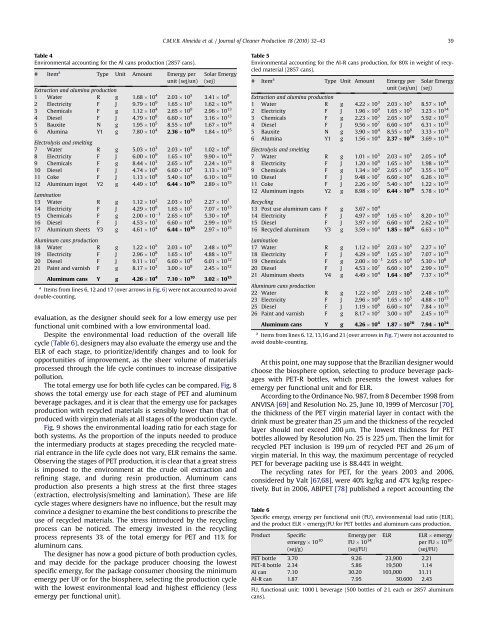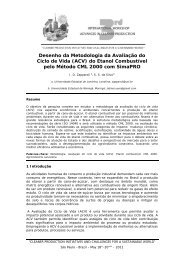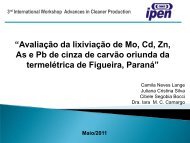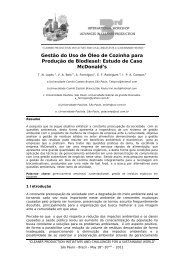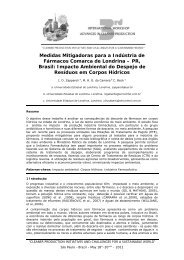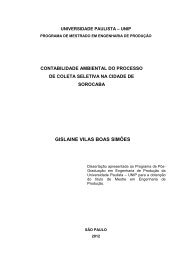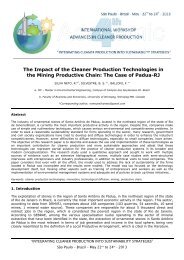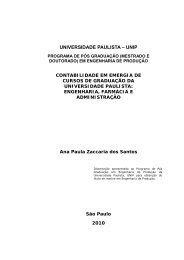Emergy as a tool for Ecodesign - Advances In Cleaner Production
Emergy as a tool for Ecodesign - Advances In Cleaner Production
Emergy as a tool for Ecodesign - Advances In Cleaner Production
You also want an ePaper? Increase the reach of your titles
YUMPU automatically turns print PDFs into web optimized ePapers that Google loves.
C.M.V.B. Almeida et al. / Journal of <strong>Cleaner</strong> <strong>Production</strong> 18 (2010) 32–43 39<br />
Table 4<br />
Environmental accounting <strong>for</strong> the Al cans production (2857 cans).<br />
# Item a Type Unit Amount <strong>Emergy</strong> per<br />
unit (sej/un)<br />
Solar <strong>Emergy</strong><br />
(sej)<br />
Extraction and alumina production<br />
1 Water R g 1.68 10 4 2.03 10 5 3.41 10 9<br />
2 Electricity F J 9.79 10 9 1.65 10 5 1.62 10 14<br />
3 Chemicals F g 1.12 10 4 2.65 10 9 2.96 10 13<br />
4 Diesel F J 4.79 10 8 6.60 10 4 3.16 10 13<br />
5 Bauxite N g 1.95 10 5 8.55 10 8 1.67 10 14<br />
6 Alumina Y1 g 7.80 10 4 2.36 10 10 1.84 10 15<br />
Electrolysis and smelting<br />
7 Water R g 5.03 10 3 2.03 10 5 1.02 10 9<br />
8 Electricity F J 6.00 10 9 1.65 10 5 9.90 10 14<br />
9 Chemicals F g 8.44 10 3 2.65 10 9 2.24 10 13<br />
10 Diesel F J 4.74 10 8 6.60 10 4 3.13 10 13<br />
11 Coke F J 1.13 10 8 5.40 10 4 6.10 10 12<br />
12 Aluminum ingot Y2 g 4.49 10 4 6.44 10 10 2.89 10 15<br />
Lamination<br />
13 Water R g 1.12 10 2 2.03 10 5 2.27 10 7<br />
14 Electricity F J 4.29 10 8 1.65 10 5 7.07 10 13<br />
15 Chemicals F g 2.00 10 1 2.65 10 9 5.30 10 8<br />
16 Diesel F J 4.53 10 7 6.60 10 4 2.99 10 12<br />
17 Aluminum sheets Y3 g 4.61 10 4 6.44 10 10 2.97 10 15<br />
Aluminum cans production<br />
18 Water R g 1.22 10 5 2.03 10 5 2.48 10 10<br />
19 Electricity F J 2.96 10 8 1.65 10 5 4.88 10 13<br />
20 Diesel F J 9.11 10 7 6.60 10 4 6.01 10 12<br />
21 Paint and varnish F g 8.17 10 2 3.00 10 9 2.45 10 12<br />
Aluminum cans Y g 4.26 10 4 7.10 10 10 3.02 10 15<br />
a Items from lines 6, 12 and 17 (over arrows in Fig. 6) were not accounted to avoid<br />
double-counting.<br />
evaluation, <strong>as</strong> the designer should seek <strong>for</strong> a low emergy use per<br />
functional unit combined with a low environmental load.<br />
Despite the environmental load reduction of the overall life<br />
cycle (Table 6), designers may also evaluate the emergy use and the<br />
ELR of each stage, to prioritize/identify changes and to look <strong>for</strong><br />
opportunities of improvement, <strong>as</strong> the sheer volume of materials<br />
processed through the life cycle continues to incre<strong>as</strong>e dissipative<br />
pollution.<br />
The total emergy use <strong>for</strong> both life cycles can be compared. Fig. 8<br />
shows the total emergy use <strong>for</strong> each stage of PET and aluminum<br />
beverage packages, and it is clear that the emergy use <strong>for</strong> packages<br />
production with recycled materials is sensibly lower than that of<br />
produced with virgin materials at all stages of the production cycle.<br />
Fig. 9 shows the environmental loading ratio <strong>for</strong> each stage <strong>for</strong><br />
both systems. As the proportion of the inputs needed to produce<br />
the intermediary products at stages preceding the recycled material<br />
entrance in the life cycle does not vary, ELR remains the same.<br />
Observing the stages of PET production, it is clear that a great stress<br />
is imposed to the environment at the crude oil extraction and<br />
refining stage, and during resin production. Aluminum cans<br />
production also presents a high stress at the first three stages<br />
(extraction, electrolysis/smelting and lamination). These are life<br />
cycle stages where designers have no influence, but the result may<br />
convince a designer to examine the best conditions to prescribe the<br />
use of recycled materials. The stress introduced by the recycling<br />
process can be noticed. The emergy invested in the recycling<br />
process represents 3% of the total emergy <strong>for</strong> PET and 11% <strong>for</strong><br />
aluminum cans.<br />
The designer h<strong>as</strong> now a good picture of both production cycles,<br />
and may decide <strong>for</strong> the package producer choosing the lowest<br />
specific emergy, <strong>for</strong> the package consumer choosing the minimum<br />
emergy per UF or <strong>for</strong> the biosphere, selecting the production cycle<br />
with the lowest environmental load and highest efficiency (less<br />
emergy per functional unit).<br />
Table 5<br />
Environmental accounting <strong>for</strong> the Al-R cans production, <strong>for</strong> 80% in weight of recycled<br />
material (2857 cans).<br />
# Item a Type Unit Amount <strong>Emergy</strong> per<br />
unit (sej/un)<br />
Solar <strong>Emergy</strong><br />
(sej)<br />
Extraction and alumina production<br />
1 Water R g 4.22 10 3 2.03 10 5 8.57 10 8<br />
2 Electricity F J 1.96 10 9 1.65 10 5 3.23 10 14<br />
3 Chemicals F g 2.23 10 3 2.65 10 9 5.92 10 12<br />
4 Diesel F J 9.56 10 7 6.60 10 4 6.31 10 12<br />
5 Bauxite N g 3.90 10 4 8.55 10 8 3.33 10 13<br />
6 Alumina Y1 g 1.56 10 4 2.37 10 10 3.69 10 14<br />
Electrolysis and smelting<br />
7 Water R g 1.01 10 3 2.03 10 5 2.05 10 8<br />
8 Electricity F J 1.20 10 9 1.65 10 5 1.98 10 14<br />
9 Chemicals F g 1.34 10 3 2.65 10 9 3.55 10 12<br />
10 Diesel F J 9.48 10 7 6.60 10 4 6.26 10 12<br />
11 Coke F J 2.26 10 7 5.40 10 4 1.22 10 12<br />
12 Aluminum ingots Y2 g 8.98 10 3 6.44 10 10 5.78 10 14<br />
Recycling<br />
13 Post use aluminum cans F g 3.67 10 4<br />
14 Electricity F J 4.97 10 8 1.65 10 5 8.20 10 13<br />
15 Diesel F J 3.97 10 7 6.60 10 4 2.62 10 12<br />
16 Recycled aluminum Y3 g 3.59 10 4 1.85 10 10 6.63 10 14<br />
Lamination<br />
17 Water R g 1.12 10 2 2.03 10 5 2.27 10 7<br />
18 Electricity F J 4.29 10 8 1.65 10 5 7.07 10 13<br />
19 Chemicals F g 2.00 10 1 2.65 10 9 5.30 10 8<br />
20 Diesel F J 4.53 10 7 6.60 10 4 2.99 10 12<br />
21 Aluminum sheets Y4 g 4.49 10 4 1.64 10 9 7.37 10 14<br />
Aluminum cans production<br />
22 Water R g 1.22 10 5 2.03 10 5 2.48 10 10<br />
23 Electricity F J 2.96 10 8 1.65 10 5 4.88 10 13<br />
25 Diesel F J 1.19 10 8 6.60 10 4 7.84 10 12<br />
26 Paint and varnish F g 8.17 10 2 3.00 10 9 2.45 10 12<br />
Aluminum cans Y g 4.26 10 4 1.87 10 10 7.94 10 14<br />
a Items from lines 6. 12, 13,16 and 21 (over arrows in Fig. 7) were not accounted to<br />
avoid double-counting.<br />
At this point, one may suppose that the Brazilian designer would<br />
choose the biosphere option, selecting to produce beverage packages<br />
with PET-R bottles, which presents the lowest values <strong>for</strong><br />
emergy per functional unit and <strong>for</strong> ELR.<br />
According to the Ordinance No. 987, from 8 December 1998 from<br />
ANVISA [69] and Resolution No. 25, June 10, 1999 of Mercosur [70],<br />
the thickness of the PET virgin material layer in contact with the<br />
drink must be greater than 25 mm and the thickness of the recycled<br />
layer should not exceed 200 mm. The lowest thickness <strong>for</strong> PET<br />
bottles allowed by Resolution No. 25 is 225 mm. Then the limit <strong>for</strong><br />
recycled PET inclusion is 199 mm of recycled PET and 26 mm of<br />
virgin material. <strong>In</strong> this way, the maximum percentage of recycled<br />
PET <strong>for</strong> beverage packing use is 88.44% in weight.<br />
The recycling rates <strong>for</strong> PET, <strong>for</strong> the years 2003 and 2006,<br />
considered by Valt [67,68], were 40% kg/kg and 47% kg/kg respectively.<br />
But in 2006, ABIPET [78] published a report accounting the<br />
Table 6<br />
Specific emergy, emergy per functional unit (FU), environmental load ratio (ELR),<br />
and the product ELR emergy/FU <strong>for</strong> PET bottles and aluminum cans production.<br />
Product<br />
Specific<br />
emergy 10 10<br />
(sej/g)<br />
<strong>Emergy</strong> per<br />
FU 10 14<br />
(sej/FU)<br />
PET bottle 3.70 9.26 23,900 2.21<br />
PET-R bottle 2.34 5.86 19,500 1.14<br />
Al can 7.10 30.20 103,000 31.11<br />
Al-R can 1.87 7.95 30.600 2.43<br />
ELR<br />
ELR emergy<br />
per FU 10 19<br />
(sej/FU)<br />
FU, functional unit: 1000 L beverage (500 bottles of 2 L each or 2857 aluminum<br />
cans).


